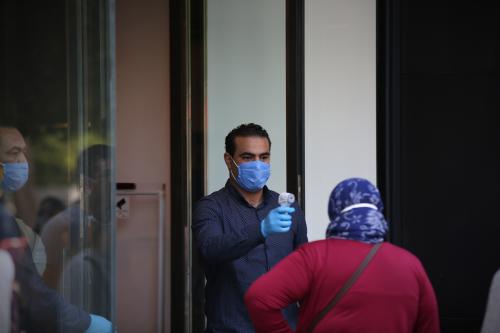Tunisia was one of the best performers during the initial wave of the COVID-19 pandemic. As the virus continued past the first few months, the country struggled to find the most appropriate balance between mitigating its health and economic dimensions. The government began relaxing economic restrictions in May and reopened Tunisia’s borders in June, leading to a spike in infections which eventually grew into a much larger second wave. The wave is expected to peak in mid-December and then ease after a portion of the population gets vaccinated (potentially in the spring of 2021). Until then, rising infections and deaths are stretching Tunisia’s public healthcare system beyond capacity and adding additional economic pressure to an already struggling population.
When facing the first wave of the coronavirus pandemic between March and September 2020, the Tunisian government responded swiftly with a comprehensive set of measures, including border closures, school closures, a national lockdown, and nightly curfews. These measures were implemented effectively and communicated extensively with the public. As a result, compared to many of its regional neighbors, Tunisia managed to successfully control the initial epidemiological threat posed by the pandemic; its number of fatalities per capita compared favorably with global leaders such as Australia and South Korea. It had the second lowest fatality rate in the Middle East and North Africa (MENA) region. In recognition of its effective response to the pandemic, the European Union began lifting restrictions on travelers coming from Tunisia in late June.
Tunisia benefited from the overall strength of the country’s health system, one of the most advanced in the MENA region. The country has strong pre-existing institutions that were able to deal with the pandemic, most notably the National Observatory of New and Emerging Diseases which was founded in 2005 under the supervision of the Ministry of Health. Other pre-existing structures include national and regional committees tasked with disaster prevention and response.
These institutions were able to work with a special committee created by the government, the National Coronavirus Response Authority (NCRA), to control the outbreak and centralize measures dealing with the pandemic. The NCRA focuses primarily upon the epidemiological aspects, coordinating activities between the different institutions and through the country’s 24 governorates. At the local level, municipal councils established local crisis committees, which worked with civil society organizations and political parties to improve local government responses to the pandemic.
Tunisia’s public health system was able to cope with the pandemic in this first phase in part because the number of cases was limited. In the wake of its initial success, the government came under pressure to reopen the economy, which it ultimately did. Due to the relaxed social distancing measures and border re-opening, Tunisia experienced a spike in the number of daily infections over the summer. On October 23, the country saw a record number of new cases (1,775). Of the total 52,399 confirmed cases on this date, 51,231 cases were recorded after Tunisia reopened its borders to international flights on June 27. As of December 8, Tunisia’s total cases stood at 105,445, its total recoveries reached 80,082, and its total deaths reached 3,668. This spike has stretched the public health sector, which is no longer able to manage the growing number of cases as intensive care units in most state hospitals are currently at maximum capacity. Currently, each COVID-19 patient is costing the state $583 per day ($801 if oxygen is required).1 At this point, the government’s response capacity is increasingly stretched and outdated.
The impact of the pandemic’s second wave has highlighted notable flaws in Tunisia’s healthcare system, including: social inequality between interior and coastal regions; a gap in specialized public health services; and strained public health institutions. Public health facilities provide free preventative services to all Tunisians regardless of income, and more than 90 percent of citizens are covered either through a free medical assistance program or through a contributing health insurance system. However, the Tunisian health care system suffers from geographic disparity in the distribution of resources (including specialized doctors and resuscitators, screening services, intensive care units, and hospital access and accommodation) favoring bigger cities and coastal towns over rural interior regions.
Throughout the pandemic, Tunisia has grappled with its economic consequences, which have greatly damaged the country’s already frail economy. By the end of 2020, the economy is expected to contract between 3.9 percent and 6 percent, and state resources might decrease by more than $1.753 billion. Unemployment is estimated to increase by 3.9 to 9.1 percentage points from its 2019 level, and the financial poverty rate may increase by 4 percentage points. To mitigate some of these impacts, the government has introduced several initiatives and support packages including a one-point reduction in a key interest rate; the relaxation of bank loan-to-deposit ratios; and establishing a guarantee fund for private sector enterprises. It has also postponed corporate tax payments; facilitated value-added tax (VAT) credit repayment; and deferred tax payment penalties. Additionally, it has allocated a one-off cash transfer to informal sector workers; delivered support packages to vulnerable groups; and distributed grants to workers at risk of losing their jobs.
Despite these important initiatives to support the private sector at the onset of the pandemic, administrative hurdles have hindered the implementation of many of these measures. While the government announced its economic recovery plan in July, this plan is yet to be implemented. As social demands rise in marginalized areas with the progression of the second wave, the government will continue to struggle with both alleviating economic pressures as well as protecting lives.
Source link : https://www.brookings.edu/articles/policy-and-institutional-responses-to-covid-19-in-the-middle-east-and-north-africa-tunisia/
Author :
Publish date : 2020-12-15 08:00:00
Copyright for syndicated content belongs to the linked Source.





